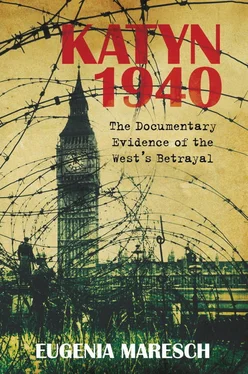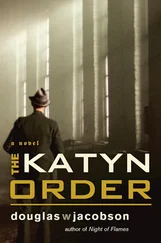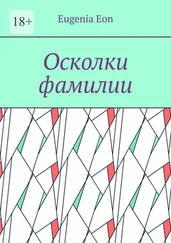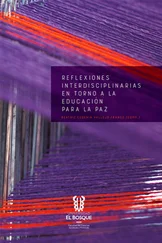Eugenia Maresch - Katyn 1940
Здесь есть возможность читать онлайн «Eugenia Maresch - Katyn 1940» весь текст электронной книги совершенно бесплатно (целиком полную версию без сокращений). В некоторых случаях можно слушать аудио, скачать через торрент в формате fb2 и присутствует краткое содержание. Город: Stroud, Год выпуска: 2010, ISBN: 2010, Издательство: Spellmount, Жанр: История, military_history, на английском языке. Описание произведения, (предисловие) а так же отзывы посетителей доступны на портале библиотеки ЛибКат.
- Название:Katyn 1940
- Автор:
- Издательство:Spellmount
- Жанр:
- Год:2010
- Город:Stroud
- ISBN:978-0-7524-6255-4
- Рейтинг книги:5 / 5. Голосов: 1
-
Избранное:Добавить в избранное
- Отзывы:
-
Ваша оценка:
- 100
- 1
- 2
- 3
- 4
- 5
Katyn 1940: краткое содержание, описание и аннотация
Предлагаем к чтению аннотацию, описание, краткое содержание или предисловие (зависит от того, что написал сам автор книги «Katyn 1940»). Если вы не нашли необходимую информацию о книге — напишите в комментариях, мы постараемся отыскать её.
The bitter dispute is ongoing between the Russian and Polish governments, to declassify the rest of the documents and concede to genocide perpetrated by the Soviets. British “Most Secret” files reveal that Katyn was considered as a provocative incident, which might break political alliance with the Soviets. The “suspension of judgment” policy of the British government hid for more than half a century a deceitful diplomacy of Machiavellian proportions.
Katyn 1940 Eugenia Maresch is the author of
;
; and
. About the Author
Katyn 1940 — читать онлайн бесплатно полную книгу (весь текст) целиком
Ниже представлен текст книги, разбитый по страницам. Система сохранения места последней прочитанной страницы, позволяет с удобством читать онлайн бесплатно книгу «Katyn 1940», без необходимости каждый раз заново искать на чём Вы остановились. Поставьте закладку, и сможете в любой момент перейти на страницу, на которой закончили чтение.
Интервал:
Закладка:
Another report entitled ‘German Propaganda’ originated in Poland and was subsequently edited by the Polish Ministry of Internal Affairs in London. The report was circulated within departments, including PWE (Political Warfare Executive) and SIS (Secret Intelligence Service) whose head, known as ‘C’, requested an extra copy, thus expressing an interest.
CHAPTER THREE
CRIME SCENE REPORTS
Throughout April and May 1943, the AK (Home Army) despatched secure signals to the Polish government in London. The first four were picked up by Oddział VI, the Polish Special Operations Bureau of the Polish General Staff, headed by Lt Col Michał Protasewicz on 19 and 26 April, 15 and 27 May 1943, respectively. [1] 1 PISM KOL 12/16/d L.dz. 518/43 secure signals from the AK (Home Army) dated 19 IV 1943 give a list of names of people who were taken to Katyn to visit the graves: Goetel, Skiwski, Seyfried, Orzechowski, Grodzki, Prochownik, Kawecki, Didur. Second group: Rev. Jasiński, Schebesta, Pragłowski, Plappert, Martens, Skarżynski, Rojkiewicz, Wodzinowski, Bartoszewski, Kołodziejski, Dmochowski, Banach; TNA FO 371/34552 C4842, L.dz. 1960/43 original and translated AK signal signed by Lt Col Michał Protasewicz, Chief of Oddział VI , dated 26 IV 1943, annotated by WS (William Strang) ‘given to S of S by General Sikorski 28/4/43’; SPP Studium Polski Podziemnej (The Polish Underground Movement Study Trust) A 7.1.1. Ref L.dz. 2290 dated 15 May 1943, a signal in Polish from ‘Kalina’ [Gen. Rowecki] for Gen. Sikorski, information among other things about the 7.65 mm bullets made by GECO and twisted ropes; PISM KOL 12/16d L.dz. 2475/tjn.43, dated 27 V 1943 gives comprehensive information about the graves as seen by the first group of the PCK committee including Skarżyński’s report in French to the International Red Cross Committee in Geneva.
Signals on 10 and 15 April covered the first two visits to Katyn by a group of Poles, who, after their return to Warsaw, were in agreement with the German statement, but probably not with the total of the dead, which they guessed. The following secure signal of 15 May, to which O’Malley referred, has been covered earlier. However, there are serious implications regarding the GECO rounds, which need clarification.
As already mentioned, the first information about the spent cartridge cases was brought to Warsaw by the first group of Poles who, after their visit to Katyn, met with Herrn Heinrich, a German official from the Propagandaamt , who immediately informed Hans Frank the Gouvernergeneral resident in Kraków. At the Nuremberg Trials on 2 July 1946, the Soviet Prosecutor Nikolai Smirnov produced Heinrich’s Teletype of 3 May 1943, sent to Herrn Oberverwaltungsrat Weirauch, claiming the Americans had offered the document to him. [2] IWM (Imperial War Museum) FO 645/289 German archives captured by US in 1945 No.A084591, USSR-507/PS-402 held at Duxford, Teletype nr. 6 of 3 May 1943 17 20 Warsaw, from Heinrich to Weirauch in Kraków.
It read:
Urgent, to be delivered at once. Secret. Part of the Polish Red Cross returned yesterday from Katyn. The employees of the Polish Red Cross have brought with them the cartridge cases, which were used in shooting the victims of Katyn. It appears that these are German munitions. The calibre is 7.65, they are from the firm Geco. Letter follows. Heinrich.
The same Polish source had sent a report to the AK Command, which reached London belatedly on 15 May 1943. It contained a sentence about the GECO rounds which was erased from the translated version passed to O’Malley, presumably by Protasewicz, who must have been alarmed by it, as it undermined the theory that the perpetrators were the Soviets, whose culpability was confirmed by all the other evidence. Dr Buhts’ report, which was part of the Amtliches Material on Katyn published in Berlin 1943, admitted that GECO ammunition from Gustav Genschow & Co, near Karlsruhe, was used for the executions; and that the retrieved bullets from the graves indicated manufacture dates between 1922 and 1931. This ammunition was exported in large quantities to Poland, the Baltic States and to Russia before the war. The War Office on this matter should, have briefed the British War Crimes Executive (BWCE). No wonder the Soviet statement at the Trials dumfounded the British lawyers, as reflected in Phillimore’s reports: ‘The Russians had much the best of the argument and rightly so.’ The FO Research Department (FORD) analysis of the Soviet report of 1944, refers to this subject again, quoting an obscure statement by the War Office that ‘the Russians are not known to use 7.65 mm pistols, but the German officers and police, widely use it – though, it is not a regular army weapon.’ These manipulations of crucial facts, brings us to the real issue, was it relevant to the case? The Soviets well knew they could not rest their case solely on the GECO ammunition as evidence against the Germans.
The inflow of secure signals that reached London indicated to the Allies that in spite of the Soviets’ refusal to accede to the formal request by the International Committee of the Red Cross to inspect the mass graves, the Germans had started a propaganda campaign by bringing groups of people, German and foreign, to witness the exhumation. More importantly, they expected the arrival of an international committee of pathologists from twelve neutral countries [3] TNA HS 4/137 and FO 371/34582 C 7677/258/55G ref SK/AK/912 carbon copy of a letter 30 June 1943, from cryptic designation SD [Pay Lt Commander Ralph C. Hollingsworth RNVR] to MPX [Richard Truszkowski] SOE Polish Section, enclosing translated report by Dr Tramsen, Danish forensic expert, who visited the graves at Katyn.
to give a verdict on the massacre. A team of Polish professionals under the auspices of the Polish PCK arrived in stages as early as 15 April 1943, while the Allied PoWs, mostly British and American, arrived involuntarily a month later, in early May 1943.
The outcome of these frequent visits to Katyn generated a number of vital additional and supplementary reports and depositions. Some were technical in nature and these can be traced in various publications: Professor Gerhard Buhtz’s Amtliches Material zum Massenmord von Katyn, Berlin 1943, which includes the official medical report of the International Committee under Dr Leonard Conte; The PCK reports written by Mr Kazimierz Skarżyński, [4] TNA FO 371/56476 N5269G typed copies of the report in Polish, translation by EM: also at PISM KOL 12/4/9; official statement by Kazimierz Skarżyński (1887–1962) a successful industrialist, educated in Vienna, Paris and Trade Institute in Antwerp, spoke seven languages. Worked for a French firm, mining copper in the Caucasus. With political unrest, acted as a liaison between the Tartars and the Kurds. In 1919 on the intervention of the British Army (note Colonel Hulls’ presence), decided to return to Poland and join the newly formed Polish army. Fought the Bolsheviks in 1920 War of Independence. In between the wars worked for a French paper firm. In 1939 finding himself without work, offered his services to the Polish Red Cross, which was duly accepted and was given the post of General Secretary. Visited Katyn burial site, wrote two reports. Fearing for his life left Poland with wife and two children in May 1946. Stopped in Nuremberg during the trials on his way to Paris. After a short stay in England, immigrated to Canada. Employed in real estate and the old Credit Froncier, this time in Calgary. Took part in Congressional Hearings in Washington in 1952. A mainstay of Polish community in Calgary.
General Secretary of the PCK, who incorporated Jerzy Wodzinowski’s report marked C, with technical drawings, into his 1943 all inclusive PCK report; and lastly, Dr Marian Wodziński’s [5] PISM KOL 12/4/37 Marian Wodziński (1911–1986) studied medicine at the Jagiellonian University in Kraków, specialised in pathology. Worked for the Court of Appeal and the Institute of Forensic Medicine in Kraków. Part of a team of Poles from the Red Cross, at the invitation of Dr Adam Schebesta of the PCK in Kraków, took part in Katyn exhumations (29 IV 1943 to 3 III 1943). In October 1943 under threat of death left Kraków for a while for Kielce district under assumed name of Cioch. In April 1944 returned to Kraków and with the Soviet front approaching, left again, this time hiding in Poznań district until September 1945, when he decided to escape from Poland for good. Settled in Liverpool, married Dr Wanda Wójcik in 1948 and continued his medical profession in Liverpool. Avoiding publicity and contacts with émigré Poles, died in 1986, his ashes were returned to Tarnów, his birthplace in Poland in August that year.
pathology report, which became the backbone of Facts and Documents concerning Polish Prisoners of War captured by the USSR during the 1939 Campaign. It was circulated in a limited edition in 1946 [6] TNA FO 371/56475 N 4406/108/55G ‘Facts and Documents’, 454-page book, Roneo-machine duplicated in foolscap for ‘private circulation only’ February 1946, PISM KOL 12/12A the original typescript in Polish, 489 pages. Includes reports and depositions by Polish PoWs, documents and correspondence, gathered from Poles inside and out of Russia compiled and edited by a special team of experts, military and civilian, called upon in December 1944 by the Council of Ministers of the Polish Government in London, among them: Colonel Jerzy Łunkiewicz, Lt Marian Heitzmann, Captain Alfred Hergesell, Roman Pucinski (translator), Wiktor Sukiennicki and many others.
and later incorporated in part in the first edition Zbrodnia Katyńska w świetle dokumentów (Katyn massacre in the light of documents) originally written and edited by Józef Mackiewecz. [7] Józef Mackiewicz (1902–1985), eminent writer and popular journalist, known for his anti-communist views. From 1922 to 1939, together with his editor brother Stanisław published a popular Wilno newspaper Słowo (The Word). In 1939 Stanisław managed to escape to the West, while Józef stayed under the Soviet–Lithuanian occupation in Wilno, He began to publish for a short while the Gazeta Codzienna (The Daily Newspaper) as both publisher and editor-in-chief but had to shut down. With German occupation of Wilno in June 1941, he was offered editorship of a new newspaper in Polish but categorically refused. In May 1943, he accepted an invitation from the German Press Bureau Gebietskommisaria Wilna-Stadt, to visit the graves at Katyn. He considered the task of national importance and was approved by the AK . On his return, he gave an interview to the infamous German-controlled Goniec Codzienny (The Daily Herald). After the war, while in exile he was castigated for doing so by the émigré Poles.
Интервал:
Закладка:
Похожие книги на «Katyn 1940»
Представляем Вашему вниманию похожие книги на «Katyn 1940» списком для выбора. Мы отобрали схожую по названию и смыслу литературу в надежде предоставить читателям больше вариантов отыскать новые, интересные, ещё непрочитанные произведения.
Обсуждение, отзывы о книге «Katyn 1940» и просто собственные мнения читателей. Оставьте ваши комментарии, напишите, что Вы думаете о произведении, его смысле или главных героях. Укажите что конкретно понравилось, а что нет, и почему Вы так считаете.












